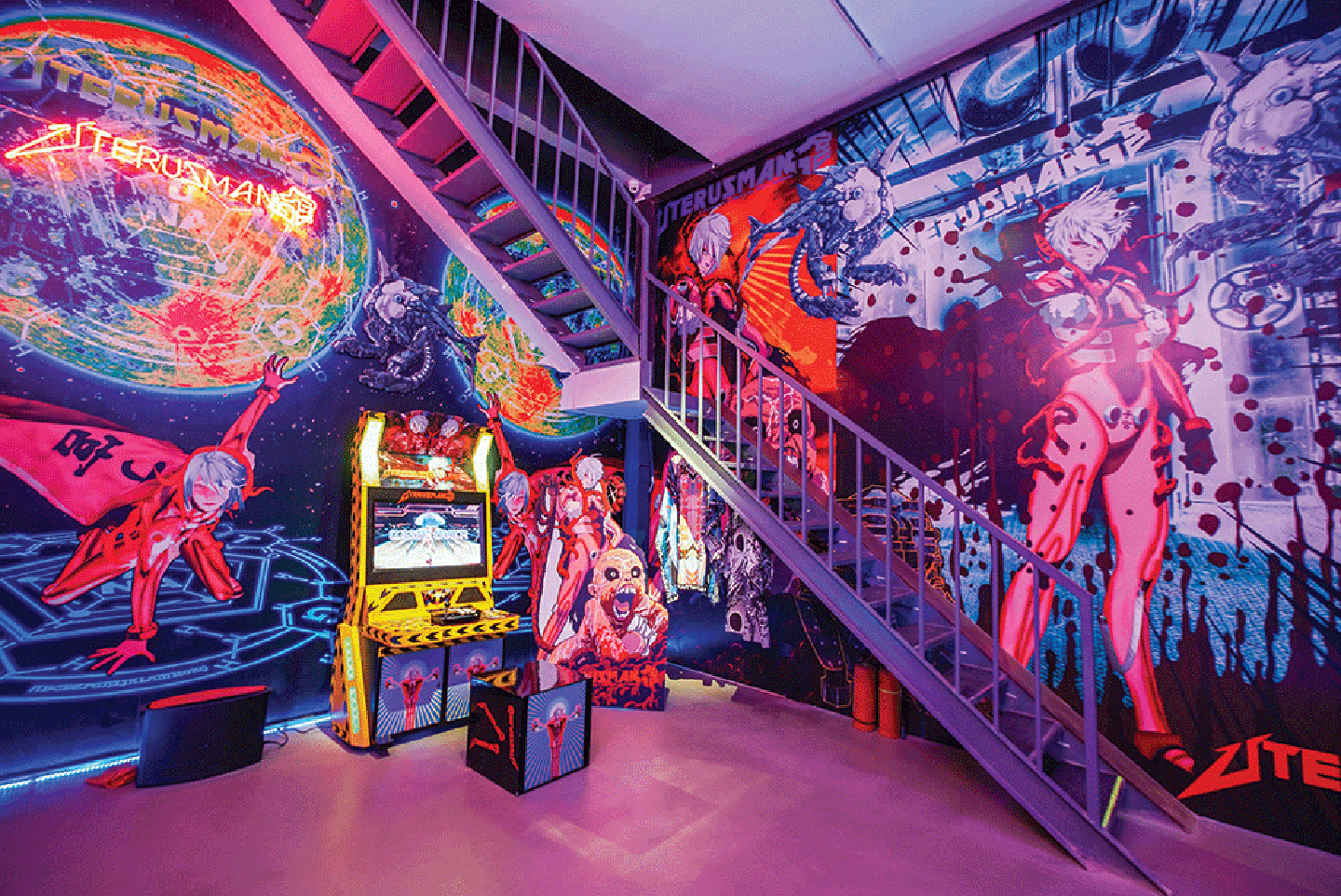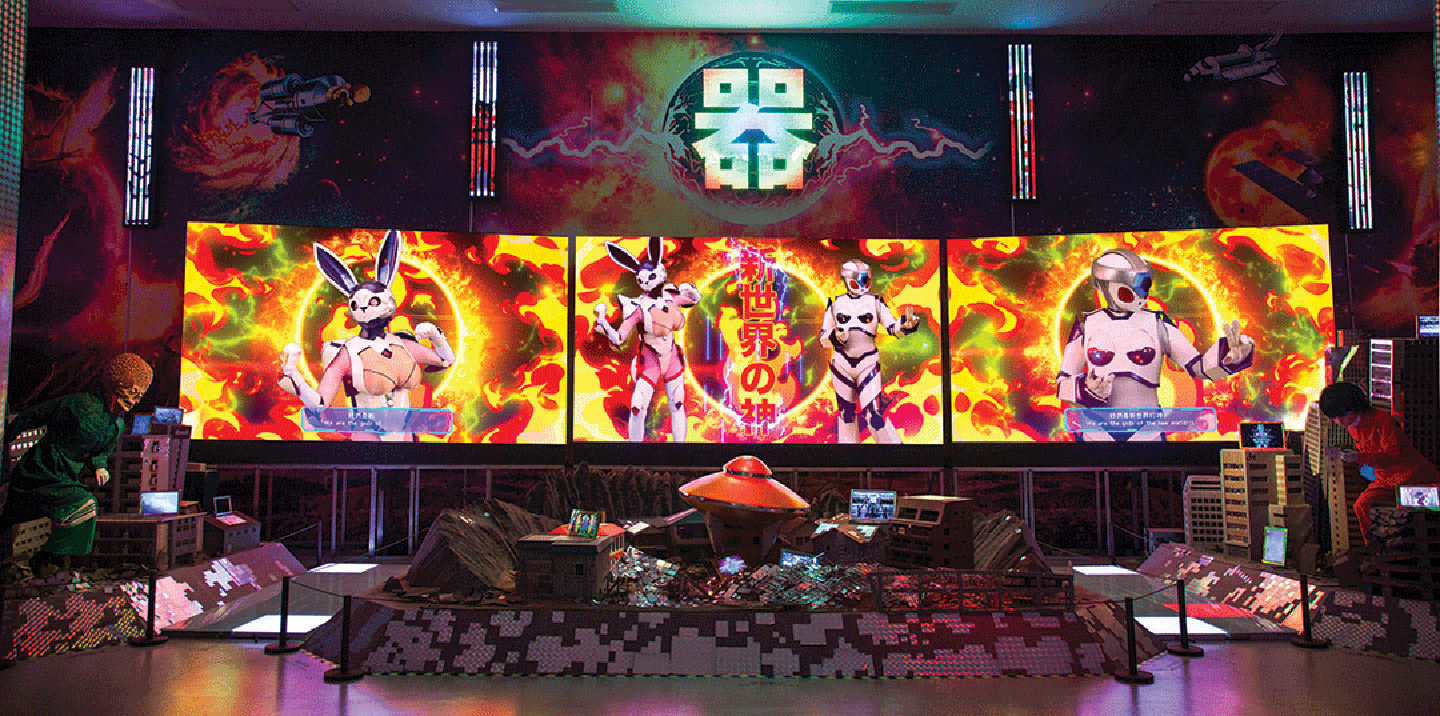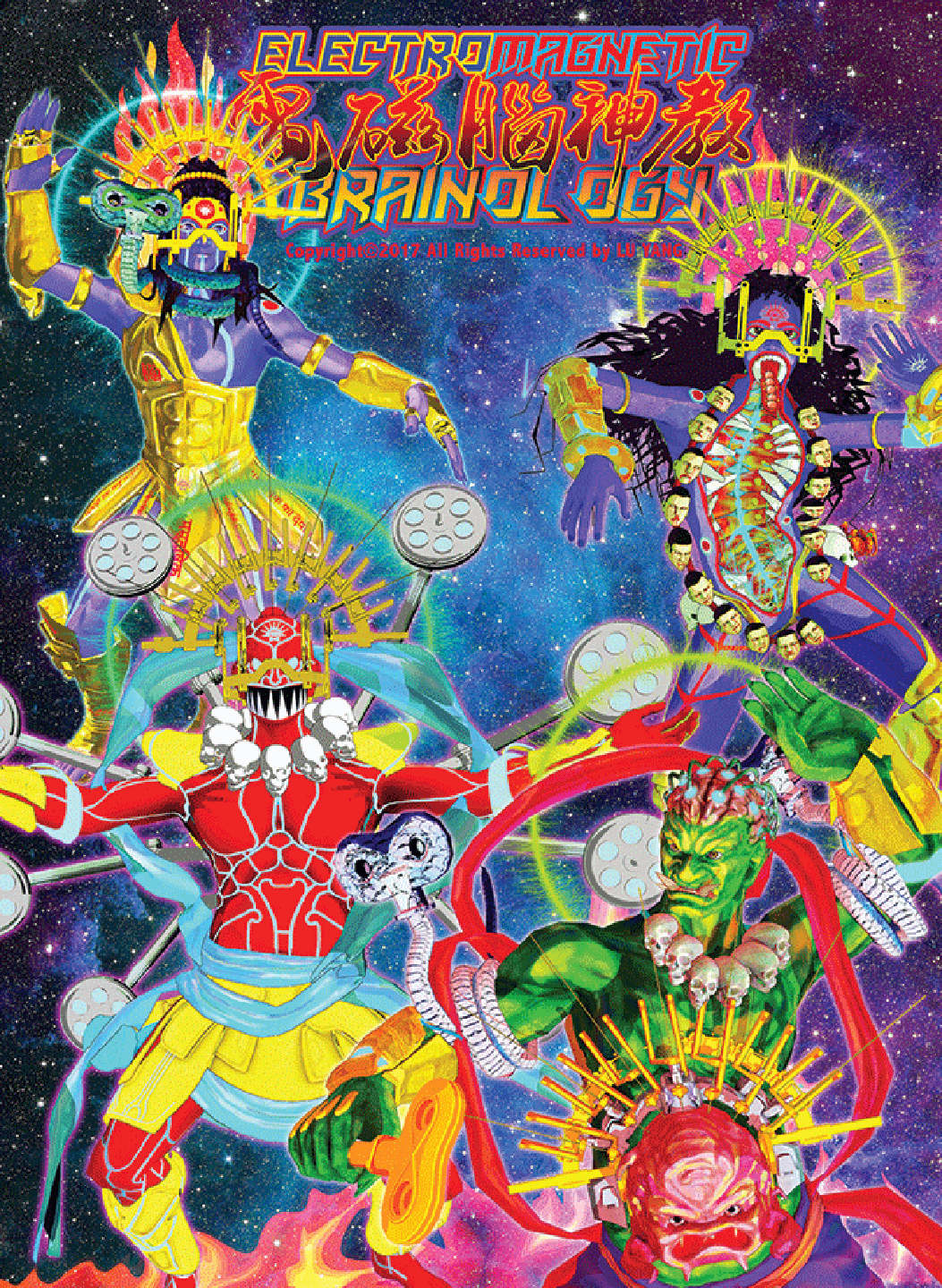« Features
Lu Yang’s Digital Realms of Creation
 Given the dynamic nature of the technologically driven and culturally amalgamated world today, the ‘look’ of our hyper-connected virtual image landscape has reached a new level of visuality. Artists around the globe are exploding the canon and exploring novel possibilities of aesthetic incarnation.
Given the dynamic nature of the technologically driven and culturally amalgamated world today, the ‘look’ of our hyper-connected virtual image landscape has reached a new level of visuality. Artists around the globe are exploding the canon and exploring novel possibilities of aesthetic incarnation.
Among her peers working in the digital realm, Lu Yang’s (born 1984, Shanghai, China) provocative style is at the forefront of the cybernated culture of art. She studied new media art at the China Academy of Art in Hangzhou, and she has since become one of the most celebrated artists of her generation. Her phantasmagorical artworks combine diverse elements and influences including neuroscience, biology, medicine, mortality, religion, Buddhist and Hindu iconography, psychology, mental illness, horror, fashion, manga, hip-hop and popular culture. Immersed in the subcultures of anime, video games and sci-fi, Lu Yang taps into the intriguing depths of these genres as well as the enormous significance of Japanese cultural imports in China and beyond. She is fond of collaborating with performers, musicians, fashion designers and comic illustrators-her art often combines these imaginative partnerships in brave and hallucinatory ways.
While much of Lu Yang’s work contains an unsettling edge of dark humor and monstrosity, her digitally rendered creations also reflect the spiritual intensity and disillusion of contemporary life. Her vibrant multimedia output spans 3D-animated films, digital video, video games, video arcade, holograms, neon, VR, sculpture, photography and installation-taken together, Lu Yang’s art embodies a wild transcultural artistic hybrid that defies all previous categorization. Her recent solo shows include Electromagnetic Brainology, Spiral, Tokyo, Japan; Lu Yang: Encephalon Heaven, M WOODS, Beijing, 2017; Delusional Mandala, abc gallery night, Société, Berlin, 2016; Delusional Mandala, Beijing Commune, 2016; and KIMO KAWA CANCER BABY, Rén Space, Shanghai, 2014. Her work has been included in numerous group exhibitions, including UCCA Center for Contemporary Art, Beijing; Centre Pompidou, Paris; 56th Venice Biennale 2015 China Pavilion; 3rd Istanbul Design Biennial; Liverpool Biennial 2016; Shanghai Biennale 2012; Montreal International Digital Art Biennial 2016; Musée d’art contemporain of Lyon; Momentum, Berlin; and The 5th Fukuoka Asian Art Triennale.
By Taliesin Thomas
Taliesin Thomas - How are the latest digital technologies changing the way you make your art or how you think about your art?
Lu Yang - Digital technology is a tool to present the work faster, but there is also the problem that I need to learn new techniques continually, and these learning processes are more time-consuming. My view of art has not changed because they are just tools. What can change your perspective and values must be a system of wisdom, not a tool.

Lu Yang, The Great Adventure of Material World, 2019, digital video, 02:24 minutes. All images are courtesy of the artist.
T.T. - Do you think your art reflects a certain ‘meta-narrative’ with respect to the relationship between humans and technology? If you had to describe that ‘meta-narrative,’ what would you call it?
L.Y. - Concerning the relationship between humans and technology, I don’t think it’s necessary to separate them. In fact, I don’t overthink about these issues. For example, I use the computer to make artworks, because the computer is more convenient and faster. The era I was born into just happened to invent the computer, so I use it. If you’re an alien, and you’re looking at the earth from another alien planet, those so-called computers, nature, humans, animals, maybe from the overall concept of the universe, are just a bunch of objects on a sphere. Just as we lie on the earth and look at the stars in the sky, we wouldn’t care what happens to any of them and our cells are fighting for their lives, we would not care about that as well. The development of technology can only say that it brings more convenience to our life, but it cannot make us happier and closer to the truth. Can you say that modern people were definitely more prosperous inside than people 2000 years ago? So, are we making progress in terms of consciousness?
T.T. - In your video piece Delusional Mandala (2015) you carry out a multimedia digitized funeral by putting yourself in a coffin and riding around a desert in a colorful truck adorned with Chinese motifs. What is your thought about death with respect to the endless virtual realm? In other words, some day we will physically die, but our online digital presence(s) will endure. What do you think about that?
L.Y. - In my works, there has always been the curiosity and exploration of death, which I think is also the universal nature of human beings. Now it is very popular to discuss the Internet and reality separately; however, I haven’t really done that. That so-called Internet, reality, dream world, I think everything that can be felt is relatively real and false, just like the ancient Chinese philosopher Zhuangzhou’s dream argument. What we now perceive as reality may be false in some way. Think about the relationship of an object and the image inside of the mirror. All kinds of death are a means of connecting all intermittency. I don’t care at all what happens to my online account after I die, it means nothing to me, and I don’t think the Internet will last forever. All the worldviews and values we build are changing in the cycle of founding, sustaining, destroying and re-founding.

Lu Yang, The Great Adventure of Material World, 2019, digital video, 02:24 minutes. All images are courtesy of the artist.
T.T. - Some theorists in the field of contemporary Chinese art discuss the notion of identity within the Chinese context as ‘identity then’ and ‘identity now.’ The ‘identity then’ model espouses biological, cultural, historical and societal definitions of identity. The ‘identity now’ model welcomes a range of interpretations about identity, including fabrications, false narratives and novel characterizations that invoke the impact of digital technologies. Do you agree with these ideas? Do you think your art reflects changing ideas about Chinese identity?
L.Y. - First of all, Chinese artists, digital artists, etc., these are all identity labels. Of course, others have to put these labels to distinguish and introduce you, but I never have these labels in my mind. I can’t represent the group of Chinese artists. I think everything can be mixed together. I like to watch all kinds of messy things, and I can try anything I want. I don’t like to distinguish, not so much to identify, but because I don’t have the ability and knowledge to make those distinctions myself. I can’t tell many things at all, even the various genres and styles within the art system. When I was in college, my art history grades were always on the borderline of passing or failing. I thought it was too much trouble to memorize so many things. Why do I have to remember so many different kinds of nouns that people invent to distinguish? If I had to keep so many other proper nouns in my head, I wouldn’t be able to maintain creative ideas in my head. This is just my condition, and I believe 99.9 percent of Chinese artists are much better than me.
T.T. - Your Uterus Man (2013) video project is an intriguing work on so many levels. The title suggests this figure is male; however, the source of this figure’s power is the female reproductive system, hence a contradictory configuration of sexuality and agency. Did you aim to make a statement about gender relations with this work?
L.Y. - This artwork is in a way ironic because the word ‘man’ is often used as a suffix for many superhuman heroes. In naming and creating characters, I deliberately follow this pattern. When this artwork was released, many people were concerned about contradictions, and it also attracted numerous sexists, but in fact, I was making a joke. As a superhero, this hero has weapons based on DNA and has techniques such as throwing a baby to attack the enemy, but few people seem to care about these superpowers, right? So, the viewer’s subjective perspective also has a lot of implications.
T.T. - In January 2019 I heard you speak at the China Institute in New York City and during that event you said: “people pay too much attention to the topic of gender.” I agree with your statement, however, I am curious about the ‘asexual’ being in some of your digital creations. What does that ‘asexual’ being express with regard to evolving ideas about gender today?
L.Y. - I spend a lot of time alone, and I really enjoy being alone. This allows easy access to your inner world, where you can think about anything as long as you are conscious. The labels you carried won’t work for you at this time, and those labels given by society won’t influence you. Not only the gender label, as the premise, but I also don’t want to attach any labels to myself to create my own world. So, there’s no gender in my work.
T.T. - At the same lecture in NYC you discussed Buddhism and Buddhist ideas about ‘giving up the body.’ Please elaborate on the influence of Buddhism in your art. When did Buddhism come into your life? Do you follow a specific school of Buddhist thought? How has Buddhism influenced your personal philosophy as an artist?
L.Y. - I may talk nonsense and forget what I said, but Buddhism has a significant influence on my creation. I came into contact with Buddhism at a young age because of my family, but the worship of the great philosophy of Buddhism may have started from my university days. In front of the media, I don’t want to talk about Buddhism with a religious concept. People need to know that the Buddha himself was not a Buddhist. Buddha advocates all the ways to make different people acceptable to the interests of his wisdom, and all schools of Buddhist thought are suitable for different people to understand Buddhism, so we don’t have to look at Buddhism in a labeled form. With my abilities, I can’t explain the great wisdom of the Buddha concisely, but his non-violent, non-binary opposition touched me.
T.T. - There is a rich backstory with respect to the development of contemporary Chinese art over the last 40 years; however, I suggest your art defies all previous categorization. How familiar are you with the art of the older generation of Chinese artists? Which artists (Chinese or Western) have been influential to you?
L.Y. - [The famed video artist] Zhang Peili is my postgraduate tutor. Maybe I know more about him than I do other artists of his generation. He doesn’t label students with his own subjective concepts, so their artworks have all kinds of styles, which are totally different from his. I think it’s his mercy as a teacher. Zhang Peili’s oil paintings in his early years were excellent. Later, he never painted anymore. Many artists can’t walk out of the comfort zone once they make achievements in a type of works, but I admire that he can. Compared with the influence of artworks, I feel that the character of the teachers has a much more profound impact on me. After all, I rarely see contemporary artworks, while animation culture, Asian ideology, various religions and technologies have a lot of influence on me.
T.T. - What areas of global art history do you consider to be important? For example, has the visual canon of Surrealism been influential to your art practice?
L.Y. - Surrealism is probably one of the few art genres that can be distinguished by my level of education. Like Dali and Bosch, the one who painted monsters and ate little people. I think the paintings of these two artists are quite interesting to look at. They are wonderful. I like them very much. I can read the figurative paintings.
T.T. - I understand you are fond of collaborations with performers, musicians, fashion designers and comic illustrators. What collaborations are you working on these days?
L.Y.- Recently, my work has been with a robotics company, Skeletonics in Tokyo, with robot idol group combination Nyorobotics in Osaka, Tokyo artist Saeborg, Tokyo band Satellite Young, Japanese idol Chanmomo, producer Invisible Manners, Tokusatsu company Marbling Fine Arts and Tokusatsu director 三池敏. These are some of the new projects I’ve been working with recently. There’s a mysterious collaboration going on right now with a very powerful master who can be called a treasure of human heritage, and hopefully next year it will be released.
T.T. - Your digital avatars are often dancing, and this reminds me of the Hindu god Shiva, the cosmic dancer setting the rhythms of the universe. Does dancing like this have any special meaning for you?
L.Y. - Different types of dances did appear in my previous works, and I actually used the dance of Shiva in two of my artworks. In terms of dance, I will make an artwork specifically about dancing soon, which explores the training and challenges of human beings to their physical limits. In addition, the backgrounds of these dances are from Asia. I have a rich Asian influence. Many religious-philosophical thoughts in Asia are deep enough to be beyond the universe and the dimensions that we can understand.

Lu Yang, Uterus Man, 2013 – 2014, mixed media: 3D animation, digital video game arcade, manga, photograph, sculptural installation, character book
T.T. - Your installations are often multilayered extravaganzas that include 3-D animation, video and sculpture simultaneously. Are you experimenting with any platforms of creation in addition to these? Are you considering Artificial Intelligence (AI) or Virtual Reality (VR) as part of your current or future projects?
L.Y. - My latest work is a game work. It is the biggest game I have ever worked on, called The Great Adventure of Material World. It is a PC-based game; this game also has a VR-experience version, but this experience version is just to be an entertainment. VR is limited by many technical issues, such as [being] prone to dizziness, comfort, camera movement and other issues and cannot present my artwork very well. I only choose the medium that can best reflect the core content of my work and never create works because of a new medium. I think if an artist creates according to the media, it puts the cart before the horse-it is led by trend and technology. Like 20 years ago, if you could make a device that could trigger infrared interaction when people get close to it, it would be a novel multimedia art. But now many people have infrared robot vacuums in their homes. I think that it is a waste of life to make artworks for short-term public attention. And the effect of doing so in artistic creation may not be as fast and convenient as being an Internet celebrity.
T.T. - Do you personally oversee the maintenance of your amazing website? What computer software programs do you use to create your digital creations?
L.Y. - My friend Bei Ou designed my website. I am so lazy that I haven’t updated it for a long time. In terms of creating artworks, I will use any software as long as I can achieve the desired results. They are too many to describe. In short, I will work with all the software that can complete the final visual effect.
T.T. - There is an unsettling dark energy in your art. What is the source or inspiration for this intense imagery?
L.Y. - It’s hard to say, but it’s certainly not a wild imagination, because I am just a human being with a weak mind and limitations…and I have personal tastes and preferences.

Lu Yang, Material World Knight, 2018. Installation view, 12th Shanghai Biennale, November 10, 2018 – March 10, 2019.
T.T. - Your work is a stunning example of a 21st-century artistic hybrid, one that combines so many difference elements. What new areas of culture or cultural ideas/histories are you considering as part of your artistic process?
L.Y. - Everything can be integrated; the possibilities are infinite.
* This interview with Lu Yang for ARTPULSE was conducted via email. Special thanks to Zhang Hanting for translating Lu Yang’s responses from Chinese into English.
Taliesin Thomas is an artist-philosopher, writer, educator, and aesthetician based in Brooklyn, N.Y., and the founding director of AW Asia (2007-present). She has lectured widely on contemporary Chinese art and has been published in ARTPULSE, Yishu: Journal of Contemporary Chinese Art, Journal of Contemporary Chinese Art (JCCA) and ArtAsiaPacific magazine. She holds an MA from Columbia University and is currently a PhD candidate in art theory and philosophy at the Institute for Doctoral Studies in the Visual Arts.





































Leave a Reply
You must be logged in to post a comment.